Textile Chemicals Market Size
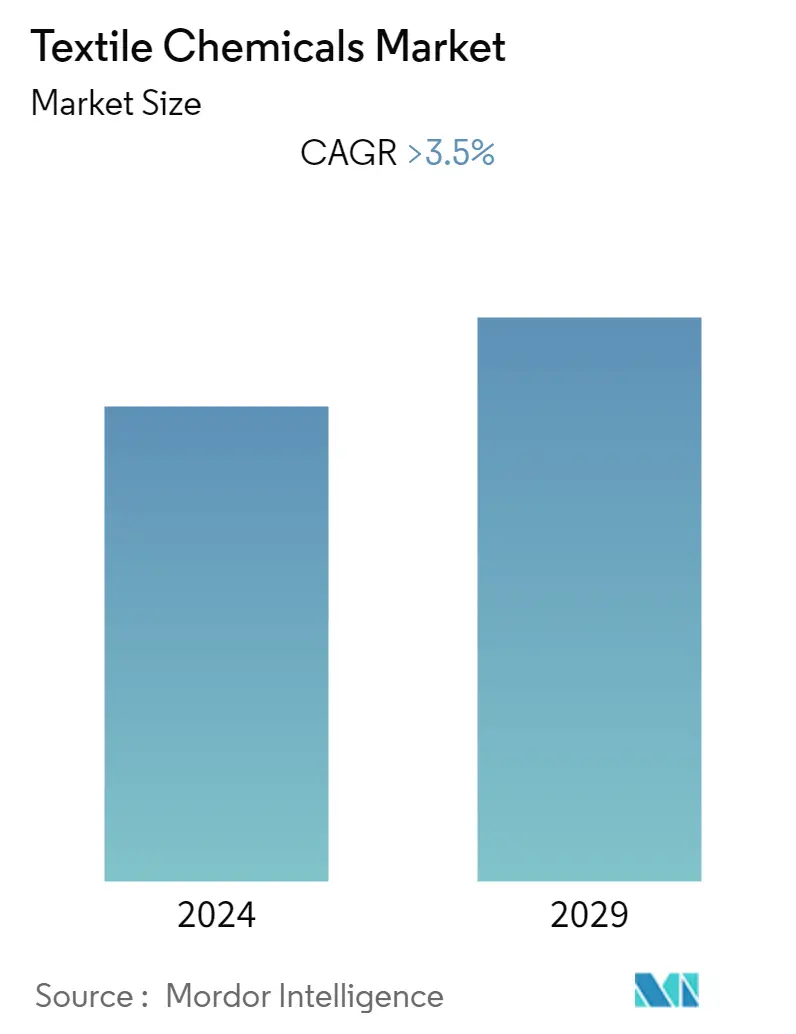
| Study Period | 2019 - 2029 |
| Base Year For Estimation | 2023 |
| CAGR | 3.50 % |
| Fastest Growing Market | Asia-Pacific |
| Largest Market | Asia-Pacific |
| Market Concentration | Low |
Major Players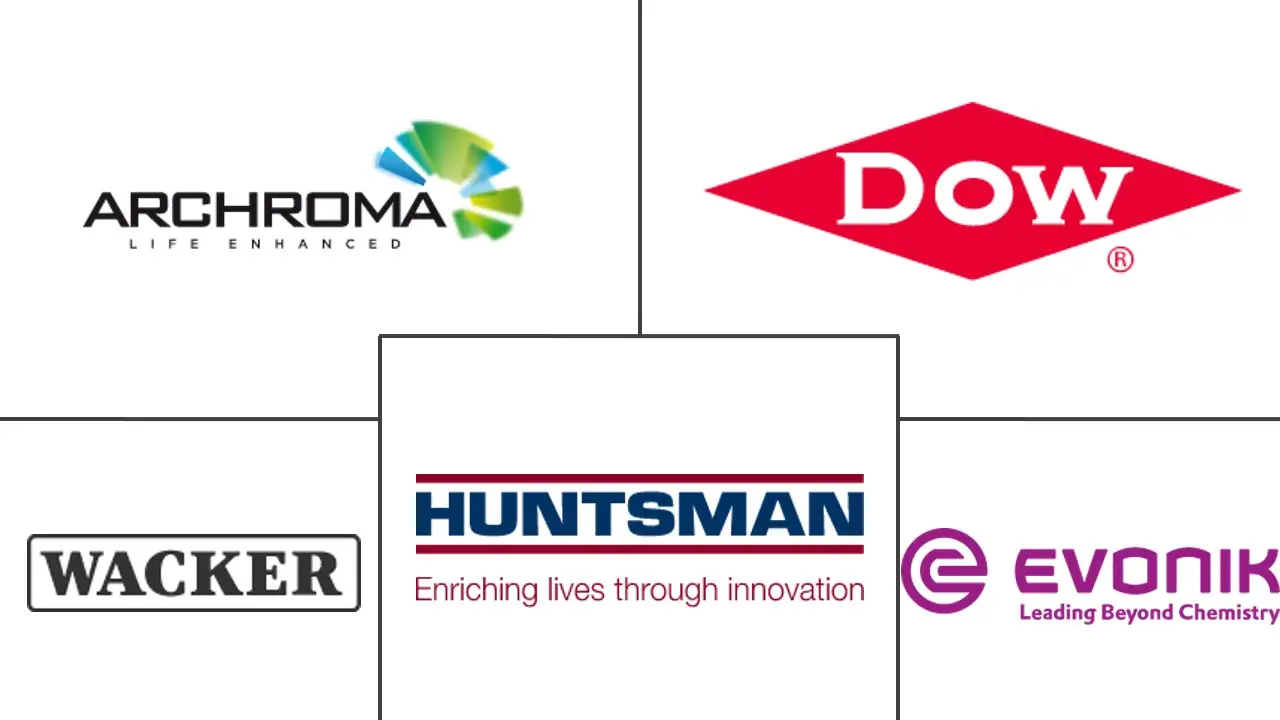
*Disclaimer: Major Players sorted in no particular order |
Textile Chemicals Market Analysis
The Global Textile Chemicals Market is projected to register a CAGR of over 3.5% during the forecasted period.
The sporadic outbreak of the COVID-19 pandemic in 2020 and the first half of 2021 drastically curtailed textile industry activities due to imposed government bans and restrictions, thereby limiting the growth of the textile chemicals market. The textile chemical sector was paralyzed owing to scarce raw material supply, limited working hours/labor strength, and constrained financials, which halted the consignment flow to the downstream textile industry. Furthermore, the demand for textiles dropped drastically as people were confined to staying in their houses. However, the industries have been on track for recovery since the pandemic's retraction in mid-2021. The demand for home, industrial, and sportswear textiles rebounded in 2022, reinstating textile contracts which increased the downstream consumption of textile chemicals and revived the interests of market players.
- Over the medium term, the robust growth in textile production in developing economies and the growing demand for industrial textiles are the major driving factors augmenting the growth of the market studied.
- On the flip side, the environmental harm caused by textile dyeing and finishing activities is anticipated to restrain the growth of the target industry over the forecast period.
- Nevertheless, the ongoing research and development activities in smart textiles and the growing urge to use low VOC and biodegradable materials for textile manufacturing will likely create lucrative growth opportunities for the global market soon.
- Asia-Pacific emerged as the largest market for textile chemicals and is expected to witness the highest CAGR during the forecast period. This dominance of Asia-Pacific is attributed to the bullish demand for textile chemicals in apparel, home furnishing, industrial, and automotive textile applications in growing economies like China and India.
Textile Chemicals Market Trends
This section covers the major market trends shaping the Textile Chemicals Market according to our research experts:
Apparel Application to Dominate the Market
- Apparel is one of the fundamental needs of a human being. The apparel segment encompasses a diverse range of value clothing, office, and business clothing, sportswear, and statement luxury pieces. Textile chemicals are hugely popular in the apparel segment, where they are used at every stage of apparel production, starting from fiber manufacturing, bleaching, dyeing, and printing designs on fabrics.
- An extensive array of chemicals classified under stabilizers, dyes, binders, softeners, leveling agents, mercerizing agents, etc., are used in apparel production. Finishing chemicals are also finding high penetration in apparel design and development to address specific requirements of the intended end use. For instance, in sportswear, antibacterial and dust-repellent clothing are gaining high importance. Similarly, wrinkle-resistant home clothing and businesswear (obtained from crosslinking with citric acid xylitol) are becoming common among the upper-middle income population.
- The modern-day apparel industry is witnessing high growth trends owing to the development of innovative designs, growing accessibility to preferable fashion choices, and the adoption of good marketing strategies by textile industry players. The increased exposure to the internet and e-commerce among consumers has improved the fashion consciousness and availability of high-end brands and limited-edition products. The evolutionary pressure from the apparel segment benefits the textile chemical market by boosting their consumption.
- Furthermore, clothing is a crucial export commodity in several countries. According to the International Labour Organization, more than 60% of the world's clothing exports are manufactured in developing countries, with Asia-Pacific accounting for 32% of the share. China, the biggest apparel market in the Asia-Pacific region, registered a 17.35% hike in garment export shipments valued at USD 189.35 billion in the first seven months of 2022, as per the General Administration of Customs China.
- On the other hand, the United States boasts a thriving fashion and clothing industry despite costly labor and raw material. The country witnessed around a 5% y-o-y increase in the total number of fashion designer businesses. Furthermore, the country has strengthened its clothing trade over the years, closing the year 2021 with USD 85,007 million export value (revealed by the US Department of Commerce and OTEXA), up by 21.07% from the apparel export value obtained in 2020.
- The increase in apparel trade and growing fashion trends are significant factors that are expected to trigger large volume consumption of textile chemicals, thus fueling the growth in the demand for the studied market during the forecast period.
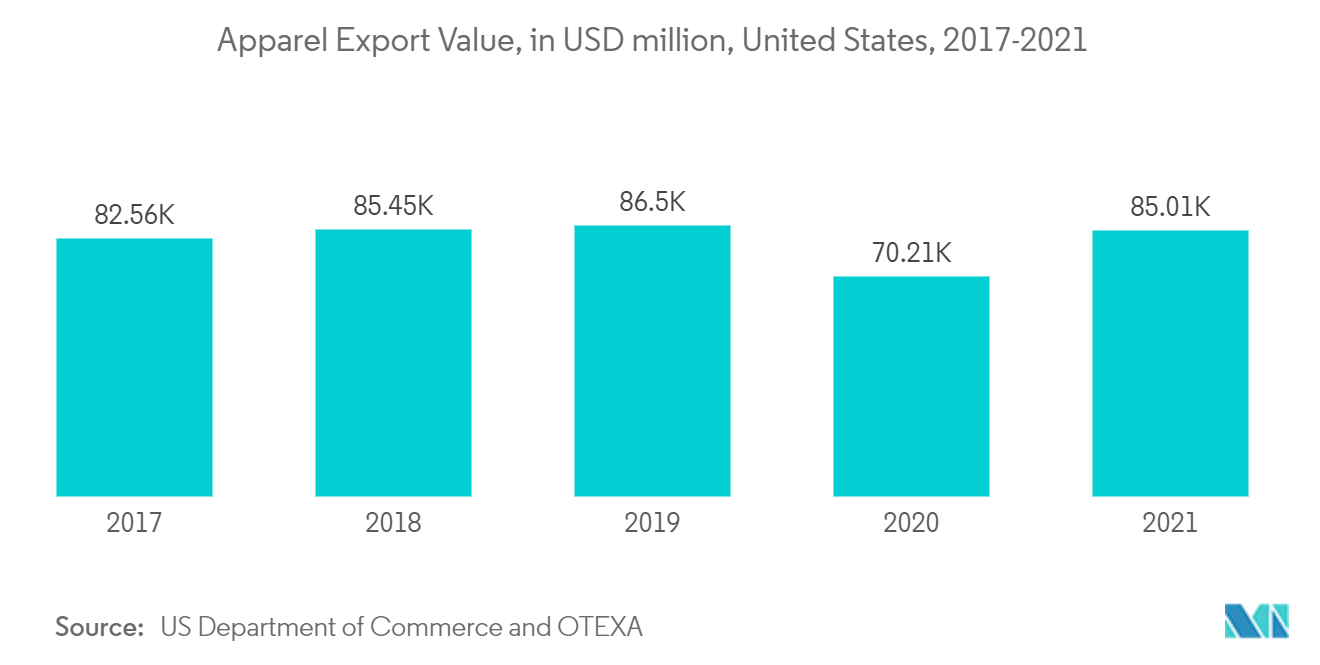
Asia-Pacific Region Expected to Dominate the Market
- The Asia-Pacific region dominates the global textile chemicals market owing to the presence of matured downstream textile manufacturing industries in countries like China, India, Bangladesh, and Vietnam. The availability of cheap labor and low production cost back the growth of the textile industry in these countries.
- Furthermore, the shift in consumer perception of affordable and comfortable clothing, as well as the expanding industrial and automotive manufacturing industries increase the demand for high-value and functional fabrics in the region.
- China owns the world's largest textile industry in terms of both production and export volumes. China's textile industry continued steady expansion in the first nine months of 2022, according to data from the country's Ministry of Industry and Information Technology. The combined operating revenue of major textile enterprises in China rose by 3.1% y-o-y reaching CNY 3.86 trillion (USD 570 billion) in that period.
- China's demographics support the attractive sales of fashion, professional and athletic apparel. The country's rising disposable income has resulted in a surge in average expenditure on clothes in the historical period. In 2022, around 60% of Chinese consumers purchased fashion apparel from domestic clothing brands.
- According to IBEF, the Indian textile and apparel industry is estimated to reach USD 190 billion by 2025-2026. India has a 4% share of the global trade in textiles and apparel. In FY 2022, India's textile and apparel exports amounted to USD 44.4 billion, registering a whopping 41% y-o-y increase.
- India's textile industry is undergoing a massive turnaround with the active enforcement of schemes such as Integrated Textile Parks (SITP) and the Technology Upgradation Fund Scheme by the government. Further, the country is expecting to attract USD 120 billion worth of foreign investments by 2025 supported by the availability of diverse natural and synthetic fibers and yarns.
- Thus, the rising investments and advancements in the textile industry are projected to benefit the textile manufacturing sector, thereby propelling the growth of the market studied.
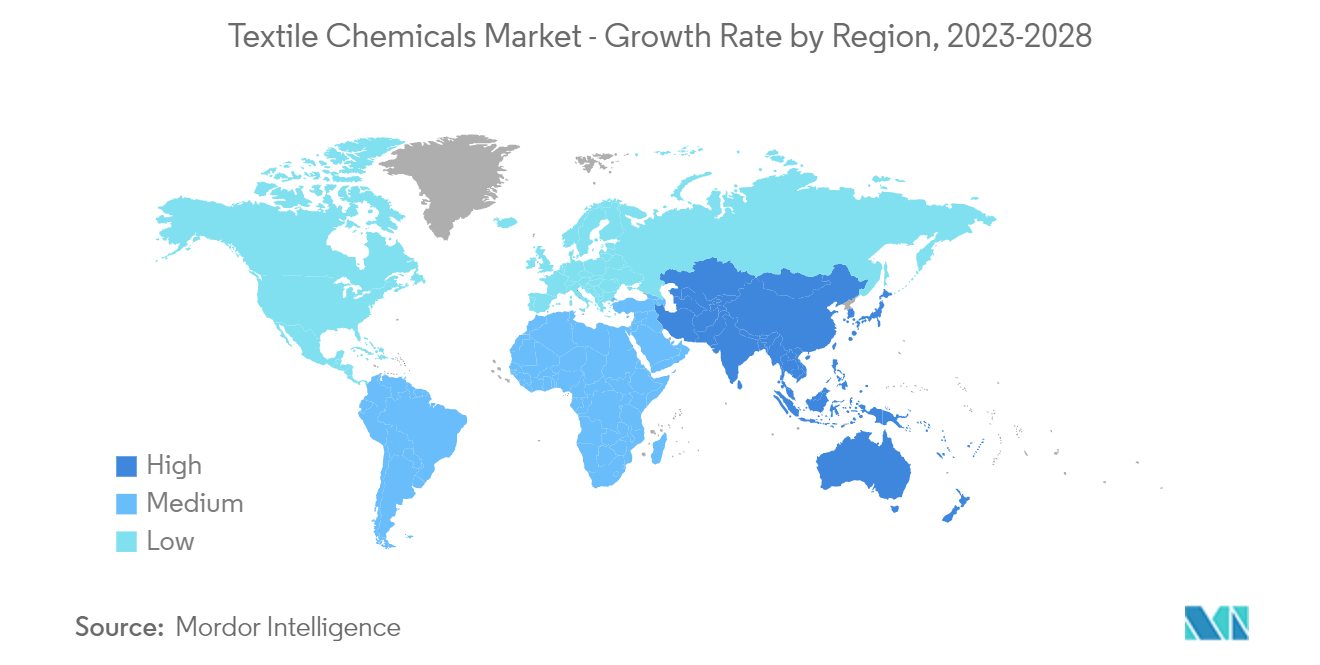
Textile Chemicals Industry Overview
The textile chemicals market is fragmented, with both international and domestic companies. Some of the major players in the market (in no particular order) include Archroma, Huntsman International LLC, Dow, Wacker Chemie AG, and Evonik Industries AG, among others.
Textile Chemicals Market Leaders
-
Archroma
-
Huntsman International LLC
-
Dow
-
Wacker Chemie AG
-
Evonik Industries AG
*Disclaimer: Major Players sorted in no particular order
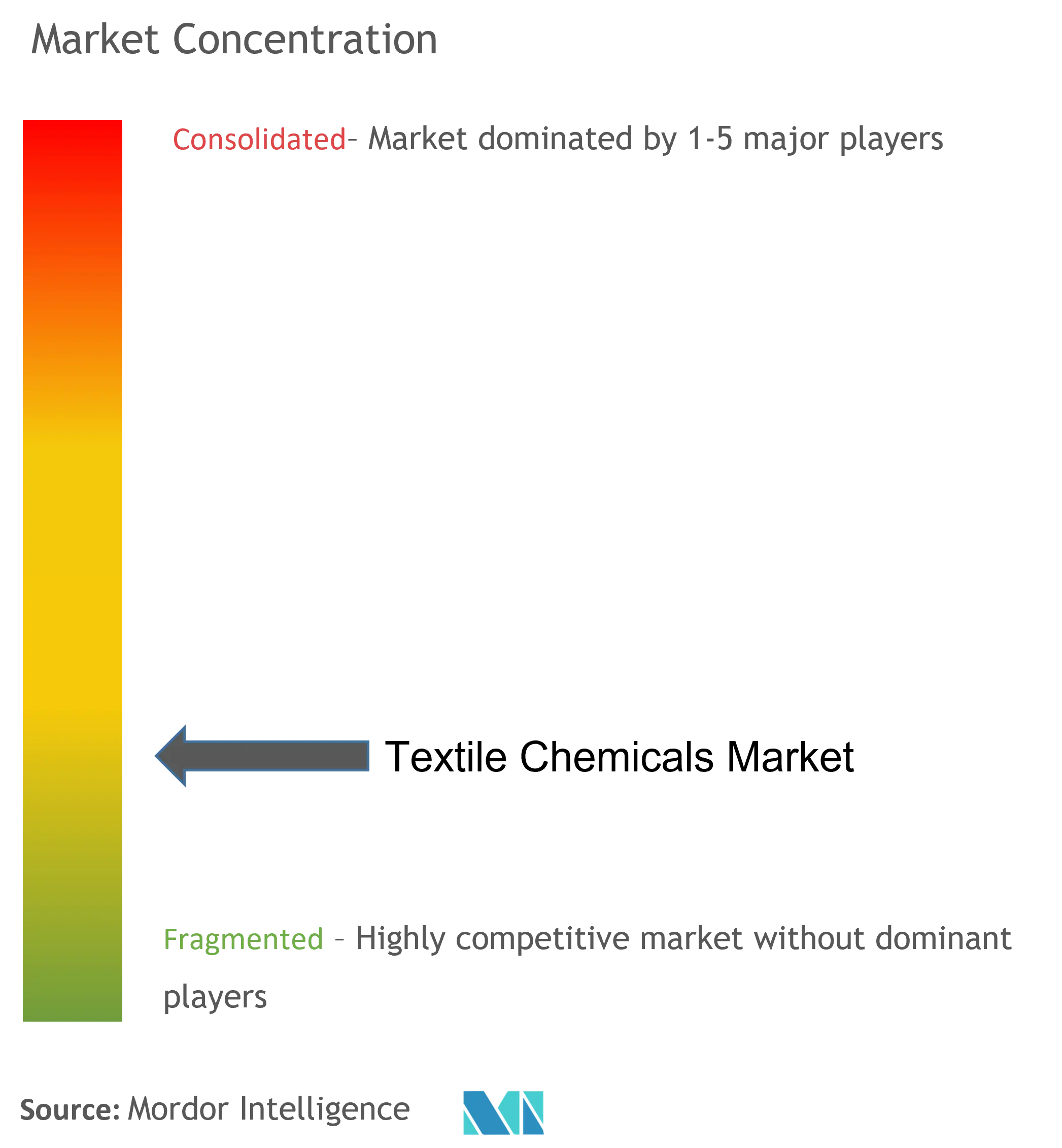
Textile Chemicals Market News
- August 2022: Archroma entered into a definitive agreement with Huntsman Corporation to acquire the latter's Textile Effect business. The transaction, awaiting regulatory approvals, is expected to close in the first half of 2023. The acquisition is expected to benefit Archroma in building a comprehensive portfolio of chemical solutions to cater to the textile market.
- February 2022: Archroma rolled out a new vegan textile softener, EARTH SOFT system based on Siligen EH1, with one-third plant-based active content. The new product line offers an alternative to textile manufacturers seeking to reduce fossil fuel-based ingredients in their end products.
Textile Chemicals Market Report - Table of Contents
1. INTRODUCTION
- 1.1 Study Assumptions
- 1.2 Scope of the Study
2. RESEARCH METHODOLOGY
3. EXECUTIVE SUMMARY
4. MARKET DYNAMICS
-
4.1 Drivers
- 4.1.1 Robust Growth in Textile Production in Developing Economies
- 4.1.2 Growing Demand for Industrial Textiles
-
4.2 Restraints
- 4.2.1 Environmental Pollution Caused by the Textile Dyeing and Finishing Industry
- 4.3 Industry Value Chain Analysis
-
4.4 Porter's Five Forces Analysis
- 4.4.1 Bargaining Power of Suppliers
- 4.4.2 Bargaining Power of Consumers
- 4.4.3 Threat of New Entrants
- 4.4.4 Threat of Substitute Products and Services
- 4.4.5 Degree of Competition
5. MARKET SEGMENTATION (Market Size in Value)
-
5.1 Type
- 5.1.1 Coating and Sizing Chemicals
- 5.1.2 Colorants and Auxiliaries
- 5.1.3 Finishing Agents
- 5.1.4 Desizing Agents
- 5.1.5 Other Types (Yarn Lubricant, Bleaching Agents, etc.)
-
5.2 Application
- 5.2.1 Apparel
- 5.2.2 Home Furnishing
- 5.2.3 Automotive Textile
- 5.2.4 Industrial Textile
- 5.2.5 Other Applications (Medical Textiles, Sports Textiles, etc.)
-
5.3 Geography
- 5.3.1 Asia-Pacific
- 5.3.1.1 China
- 5.3.1.2 India
- 5.3.1.3 Japan
- 5.3.1.4 South Korea
- 5.3.1.5 ASEAN Countries
- 5.3.1.6 Rest of Asia-Pacific
- 5.3.2 North America
- 5.3.2.1 United States
- 5.3.2.2 Canada
- 5.3.2.3 Mexico
- 5.3.3 Europe
- 5.3.3.1 Germany
- 5.3.3.2 United Kingdom
- 5.3.3.3 Italy
- 5.3.3.4 France
- 5.3.3.5 Rest of Europe
- 5.3.4 South America
- 5.3.4.1 Brazil
- 5.3.4.2 Argentina
- 5.3.4.3 Rest of South America
- 5.3.5 Middle-East and Africa
- 5.3.5.1 Saudi Arabia
- 5.3.5.2 South Africa
- 5.3.5.3 Rest of Middle-East and Africa
6. COMPETITIVE LANDSCAPE
- 6.1 Mergers and Acquisitions, Joint Ventures, Collaborations, and Agreements
- 6.2 Market Share(%)**/Ranking Analysis
- 6.3 Strategies Adopted by Leading Players
-
6.4 Company Profiles
- 6.4.1 Achitex Minerva SpA
- 6.4.2 Archroma
- 6.4.3 Arkema Group
- 6.4.4 Chemipol (Kothari Group Of Industries)
- 6.4.5 CHT Group
- 6.4.6 Covestro AG
- 6.4.7 Croda International PLC
- 6.4.8 Dow
- 6.4.9 Evonik Industries AG
- 6.4.10 Formosa Organic Chemical Industry Co. Ltd
- 6.4.11 Giovanni Bozzetto SpA
- 6.4.12 Huntsman International LLC
- 6.4.13 Kemira Oyj
- 6.4.14 K-tech (India) Limited
- 6.4.15 L. N. Chemical Industries
- 6.4.16 Kiri Industries Ltd
- 6.4.17 Nouryon
- 6.4.18 Rudolf GmbH
- 6.4.19 Sarex
- 6.4.20 Tanatex Chemicals BV
- 6.4.21 The Lubrizol Corporation
- 6.4.22 Wacker Chemie AG
- *List Not Exhaustive
7. MARKET OPPORTUNITIES AND FUTURE TRENDS
- 7.1 Ongoing Research and Development in the Field of Smart Textiles
- 7.2 Growth in Demand for Low VOC and Biodegradable Materials for Textile Manufacturing
Textile Chemicals Industry Segmentation
Textile chemicals are specialty chemicals used during the dyeing and processing textiles to impart desired properties to an array of end products used in clothing, bedding, carpets, car interiors, industries, etc. Processing natural or artificial fabrics with textile chemicals improves textile wearability, functionality (such as imparting antibacterial features, flame retardancy, etc.), and appearance. The textile chemicals market is segmented by type, application, and geography. By type, the market is segmented into coating and sizing chemicals, colorants and auxiliaries, finishing agents, de-sizing agents, and other types. By application, the market is segmented into apparel, home furnishing, automotive textile, industrial textile, and other applications. The report also covers the size and forecasts for the textile chemicals market in 15 countries across major regions. For each segment, the market sizing and forecasts have been done on the basis of value (USD Million).
| Type | Coating and Sizing Chemicals | |
| Colorants and Auxiliaries | ||
| Finishing Agents | ||
| Desizing Agents | ||
| Other Types (Yarn Lubricant, Bleaching Agents, etc.) | ||
| Application | Apparel | |
| Home Furnishing | ||
| Automotive Textile | ||
| Industrial Textile | ||
| Other Applications (Medical Textiles, Sports Textiles, etc.) | ||
| Geography | Asia-Pacific | China |
| India | ||
| Japan | ||
| South Korea | ||
| ASEAN Countries | ||
| Rest of Asia-Pacific | ||
| Geography | North America | United States |
| Canada | ||
| Mexico | ||
| Geography | Europe | Germany |
| United Kingdom | ||
| Italy | ||
| France | ||
| Rest of Europe | ||
| Geography | South America | Brazil |
| Argentina | ||
| Rest of South America | ||
| Geography | Middle-East and Africa | Saudi Arabia |
| South Africa | ||
| Rest of Middle-East and Africa |
Textile Chemicals Market Research FAQs
What is the current Textile Chemicals Market size?
The Textile Chemicals Market is projected to register a CAGR of greater than 3.5% during the forecast period (2024-2029)
Who are the key players in Textile Chemicals Market?
Archroma, Huntsman International LLC, Dow, Wacker Chemie AG and Evonik Industries AG are the major companies operating in the Textile Chemicals Market.
Which is the fastest growing region in Textile Chemicals Market?
Asia-Pacific is estimated to grow at the highest CAGR over the forecast period (2024-2029).
Which region has the biggest share in Textile Chemicals Market?
In 2024, the Asia-Pacific accounts for the largest market share in Textile Chemicals Market.
What years does this Textile Chemicals Market cover?
The report covers the Textile Chemicals Market historical market size for years: 2019, 2020, 2021, 2022 and 2023. The report also forecasts the Textile Chemicals Market size for years: 2024, 2025, 2026, 2027, 2028 and 2029.
Textile Chemicals Industry Report
Statistics for the 2024 Textile Chemicals market share, size and revenue growth rate, created by Mordor Intelligence™ Industry Reports. Textile Chemicals analysis includes a market forecast outlook to 2029 and historical overview. Get a sample of this industry analysis as a free report PDF download.



